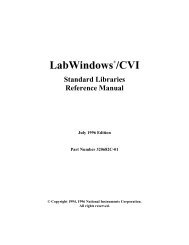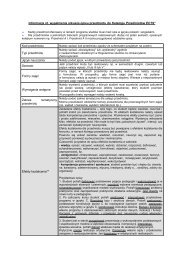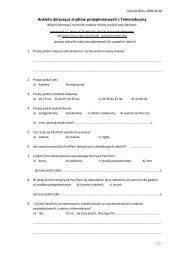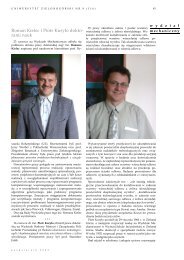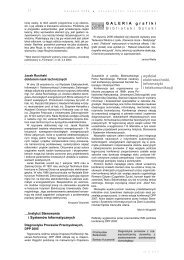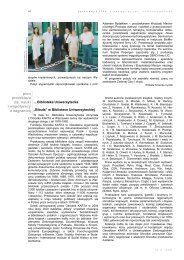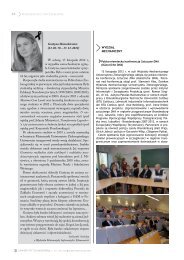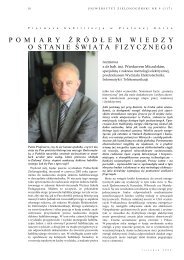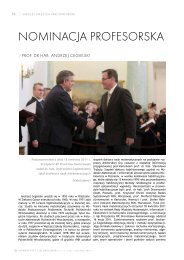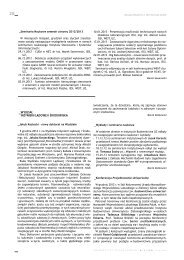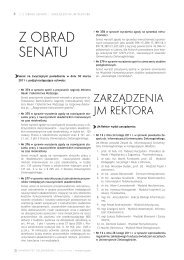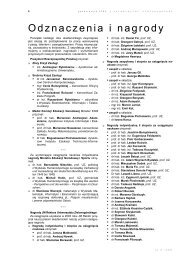SEED GERMINATION OF SELECTED PLANTS UNDER ... - CEER
SEED GERMINATION OF SELECTED PLANTS UNDER ... - CEER
SEED GERMINATION OF SELECTED PLANTS UNDER ... - CEER
You also want an ePaper? Increase the reach of your titles
YUMPU automatically turns print PDFs into web optimized ePapers that Google loves.
CIVIL AND ENVIRONMENTAL ENGINEERING REPORTSNo. 7 2011<strong>SEED</strong> <strong>GERMINATION</strong> <strong>OF</strong> <strong>SELECTED</strong> <strong>PLANTS</strong> <strong>UNDER</strong>THE INFLUENCE <strong>OF</strong> HEAVY METALSMichał DRAB 1∗ , Andrzej GREINERT 2 , Jakub KOSTECKI 3 , MonikaGRZECHNIK 41,2,3 Institute of Environmental EngineeringUniversity of Zielona GóraSzafrana st 15, 65-516 Zielona Góra, Poland,4 Student graduated in Institute of Environmental EngineeringUniversity of Zielona Góra, PolandIn the paper has been presented the influence of selected heavy metals salts solutions:CuSO 4 , Pb(NO 3 ) 2 , ZnCl 2 and Cd(NO 3 ) 2 on the germination of seeds of the higher plants.The solutions with the various concentrations of abovementioned salts have been testedon seeds of the following plants: rye (Secale cereale L.), common wheat (Triticumaestivum L.), rape (Brassica napus oleifera L.) and white mustard (Sinapis alba L.). Thepot experiment was carried out in laboratory conditions. Each variant of the experimenthas been made in three replications. After the 7 days of germination, number of thegerminated seeds was counted. There was no significant variation of the impact of thesolutions tested on seeds used in the experiment. The influence of CuSO 4 was the higheston seed germination in all the plants except rye. Higher concentrations of the salts causedreduced germination of most from the tested plants.Keywords: cadmium, copper, germination, heavy metals, lead, seeds, zinc1. INTRODUCTIONThe group of heavy metals are: Cd, Cr, Cu, Pb, Hg, Ni, Zn [30], although someauthors [22] include in this group also Se, some others eligible there elementswith a density of 4.5 g cm -3 [5] and still others [3] ones heavier than 6 g cm -3 .Despite the widespread use of the term "heavy metals" including a number ofelements mentioned above, the definition of "heavy metals" is not uniform anddepends on the criterion for division [8].∗ Corresponding author. E-mail: m.drab@iis.uz.zgora.pl
48 Michał Drab, Andrzej Greinert, Jakub Kostecki, Monika GrzechnikThe presence of heavy metals in the environment can be natural(background) or anthropogenic. The primary source of metals such as copper,cadmium, zinc and lead in soil is the weathering of rocks [12]. As a result ofanthropogenic activity, elements enter the environment by artificial means suchas being released into the environment from municipal wastes, pesticides,industrial and automotive emissions.The content of heavy metals in different soils varies considerably –depending on the type of soil and the country of origin of samples, due to thedifferent contents of these elements in parent rocks. Kabata-Pendias & Pendias[11] reported that the average copper content in the upper layers of the profilesare 13 – 24 mg kg -1 , lead from 22 to 44 mg kg -1 , zinc 45 – 100 mg kg -1 ,cadmium 0,37 – 0,78 mg kg -1 .The ranges and means of the total concentration of selected heavy metalsare summarized in Table 1.Table 1. The ranges and means of the total concentration of selected heavy metals in topsoil, in mg·dm -3 [11]Podzols Cambisols Rendzinas Kastanozems& chernozemsHistosolsa) b) a) b) a) b) a) b) a) b)Cu 1-7013 4-100Pb 2,3- 22 1,5-7070Zn 3,5- 45 9-220 362Cd 0,01- 0,3 0,08-2,7 7 1,61a) range value, b) mean value23 6,8-7028 10-5060 10-5700,45 0,38-0,8423 6,5-14026 8-7010 20-0 7700,6 0,18-2 0,7124 1-11323 1,5-17665 5-2500,44 0,19-2,2Data about the natural content of copper, lead, cadmium and zinc(background) in various environment elements is collected in Table 2.Table 2. Background content of selected heavy metals in various environments [5]Soils,mg·dm -3Marinewaters,µg·dm -3Inland waters,µg·dm -3Atmosphere,ng·dm -31644500,78Plants,mg·dm -3 d.m.Cu 5,0-15,0 0,01-0,02 0,003 ≤ 4,0 5,0-30,0Pb 20,0-40,0 0,01-0,04 0,1-0,2 0,1-1,0 0,5-7,0Zn 10,0-125,0 0,03-0,14 5,0-70,0 10,0 25,0-150,0Cd 0,05-0,7 0,01 0,02-0,1 0,003-0,6 0,05-0,5The presence of heavy metals in the environment is a serious ecologicalproblem, because these elements can enter food chains and the biological cycle[16]. They can eventually affecting animals and humans and causing metabolic
Seeds germination of selected plants under the influence of some heavy metals 49disorders and damages to internal organs, including liver, kidneys and brain [7,31].Some of these elements (such as Cu, Zn) are essential for livingorganisms, because they are presented in the enzymes composition catalyzingimportant life processes [3]. Heavy metals are relatively easily extracted fromthe soil solution by plants and strongly affect their metabolism. In extreme casesthey may cause their deadly poisoning [9, 10, 17].Heavy metals can be defined as a stress factor, which may lead todisturbances of a number of functions of organisms [1, 2, 16, 19, 21, 24, 25, 26].The results presented by a number of authors [1, 14, 27, 30], clearly indicate anegative impact of heavy metals on seed germination. This limitation impactdepends mainly on heavy metals, the concentration applied and plant species [1,14, 15, 27].The aim of this study was to investigate the impact of variousconcentrations of 4 salts of heavy metals, such as CuSO 4 , Pb(NO 3 ) 2 , ZnCl 2 ,Cd(NO 3 ) 2 on the strength of seed germination of rye (Secale cereale L.), wheat(Triticum aestivum L.), rape (Brassica napus oleifera L.) and white mustard(Sinapis alba L.).2. MATERIAL AND METHODSThe experiment was carried out in laboratory conditions. All the tests werecarried out according to the Polish standard [18]. Experiment was made as arandom blocks method with three replications.The experiment was constructed by means of the method of randomblocks with three replications.The experiment was split into 2 parts. In the first part we madea preliminary test, where all the seeds were treated with varied concentrations ofsolutions of heavy metals. After 7 days the number of germinated seeds wascounted. This number was compared with seeds of plants treated withdistilledH 2 O. All the results from this part of the experiment were used in thesecond part – 20 seeds of selected plants were put in Petri dishes and treatedwith each solution. Concentrations of the solutions tested are presented intable 3.Table 3. Concentrations of the tested solutionsSalt Concentration (mg·dm -3 )Cd(NO 3 ) 2 0 4 8 12 16 20CuSO 4 0 4 8 12 16 20Pb(NO 3 ) 2 0 10 20 50 100 150ZnCl 2 0 20 40 60 80 100
50 Michał Drab, Andrzej Greinert, Jakub Kostecki, Monika GrzechnikThe strength of seed germination was evaluated after 7 days ofincubation. The results obtained were analysed statistically using the StatsoftStatistica 8 software. LSD values calculated this way are presented in Table 4.Table 4a. Mean values of germinated seeds of Secale cereale L. and Tritcum aestivum L.RyeCommon wheatTestedConcentration Quantity Concentration Quantitysolutionsmg·dm -3 Pieces % mg·dm -3 Pieces %H 2 O Mean value 16,0 80,0 Mean value 18,0 90,04 13,7 68,5 4 14,3 71,58 8,7 43,5 8 12,0 60,0Cd(NO 3 ) 212 8,3 41,5 12 12,0 60,016 5,3 26,5 16 11,0 55,020 2,7 13,5 20 10,3 51,5Mean value 7,7 38,5 Mean value 11,9 59,54 10,7 53,5 4 13,7 68,58 9,7 48,5 8 10,7 53,5CuSO 412 9,3 46,5 12 9,7 48,516 7,3 36,5 16 8,3 41,520 7,0 35,0 20 8,0 40,0Mean value 8,8 44,0 Mean value 10,1 50,510 10,7 53,5 10 16,3 81,520 8,0 40,0 20 13,7 68,5Pb(NO 3 ) 250 8,3 41,5 50 10,3 51,5100 4,3 21,5 100 10,0 50,0150 3,0 15,0 150 9,0 45,0Mean value 6,9 34,5 Mean value 11,9 59,520 13,0 65,0 20 16,7 83,540 10,0 50,0 40 14,3 71,5ZnCl 260 9,3 46,5 60 14,3 71,580 6,3 31,5 80 10,0 50,0100 4,0 20,0 100 8,3 41,5Mean value 8,5 42,5 Mean value 12,7 63,5LSD 0,01 for concentration = 3,3piecesLSD 0,01 for salt = 2,2 piecesLSD 0,01 for concentration = 3,2piecesLSD 0,05 for interaction = 6,4 pieces
Seeds germination of selected plants under the influence of some heavy metals 51Tab. 4b. Mean values of germinated seeds of Brassica napus oleifera L. and Sinapisalba L.RapeWhite mustardTestedConcentration Quantity Concentration Quantitysolutionsmg·dm -3 Pieces % mg·dm -3 Pieces. %H 2 O Mean value 18,0 90,0 Mean value 19,0 95,04 16,7 83,5 4 16,7 83,58 16,0 80,0 8 13,7 68,5Cd(NO 3 ) 212 10,0 50,0 12 11,0 55,016 9,7 48,5 16 9,7 48,520 9,0 45,0 20 8,0 40,0Mean value 12,3 61,5 Mean value 11,8 59,04 14,7 73,5 4 15,7 75,58 13,0 65,0 8 12,7 63,5CuSO 412 12,0 60,0 12 6,0 30,016 6,0 30,0 16 5,0 25,020 4,7 23,5 20 2,7 13,5Mean value 10,1 50,5 Mean value 8,4 42,010 16,7 83,5 10 17,0 85,020 16,7 83,5 20 15,7 78,5Pb(NO 3 ) 250 14,0 70,0 50 12,0 60,0100 8,0 40,0 100 11,7 58,5150 7,7 38,5 150 9,3 46,5Mean value 12,6 63,0 Mean value 13,1 65,520 15,0 75,0 20 17,3 86,540 13,7 68,5 40 16,7 83,5ZnCl 260 9,0 45,0 60 16,0 80,080 9,0 45,0 80 13,0 65,0100 5,0 25,0 100 9,0 45,0Mean value 10,3 51,5 Mean value 14,4 72,0LSD 0,01 for metals = 1,7 piecesLSD 0,01 for concentrations= 1,9piecesLSD 0,01 for interactions = 4,6piecesLSD 0,01 for metals = 2,4 piecesLSD 0,01 for concentrations = 2,9piecesLSD 0,01 for interactions = 5,7pieces3. RESULTSThe salts of heavy metals used in these studies had a negative impact on thegermination of rye seeds (Table 4). There was no significant difference betweenthe effects of various metal salts on the strength of the germination of rye.Pb(NO 3 ) 2 had the most decreasing effect (mean 65.5%). CuSO 4 and ZnCl 2 hadthe least decreasing effect (56% and 57.5%).
52 Michał Drab, Andrzej Greinert, Jakub Kostecki, Monika GrzechnikIncreasing concentrations of salt solutions significantly reduced thestrength of germination of rye seeds. Salts with a high concentration of selectedmetals had the most negative impact on the feature under discussion. Thegreatest reduction in the strength of germination was found in the case ofCd(NO 3 ) 2 from 68.5% under the influence 4 mg·cm -3 to 13.5% under theinfluence of the concentration of 20 mg·cm -3 .The heavy metal salts applied significantly diversified the strength ofwheat seed germination – LSD = 2.2 pieces. The least harmful salt was ZnCl 2 –the average germination was 63.5%. CuSO4 was found to be the most toxic one,the average value of the features analysed was 50.5%.Increasing concentrations of heavy metals have resulted the importantdecrease of germination strength of wheat seeds. LSD for the concentrations ofthe solutions was 3.2 pieces, p ≤ 0,01. The lowest concentrations of all thesolutions of salts of heavy metals had the least harmful influence on the featureunder discussion. The greatest influence was found when the highestconcentrations of salts were used.It should be emphasized that the slightest variation of the strength ofgermination of wheat seeds under the influence of increasing concentrationsoccurred in the case of copper sulphate, while the largest decreases in thestrength of germination was found under the influence of increasingconcentrations of zinc chloride.The metal salts used in this experiment significantly varied the strength ofthe germination of rape seeds (Table 4), LSD was 1.7 pieces, p ≤ 0,01. Thelowest number of germinated seeds was found when a solution of coppersulphate was used, on average 50.5%. The highest number of germinated seedswas obtained after the use of lead nitrate – an average of 63.0%.Each time, an increase in the concentrations of the salts tested induced areduction in the strength of germination of rape seeds. These differences wereproven statistically, LSD was 1.9 pieces, p ≤ 0,01. A reduction in the strength ofgermination of rape seeds under the influence of increasing concentrations of allthe salts was relatively high and exceeded 40%, in the case of the application ofcopper sulphate and zinc chloride we reached 50%.All the solutions of the salts tested significantly varied the strength ofgermination of mustard seeds (Table 4), LSD = 2.4 pieces, p ≤ 0.01. Thegermination of seeds of this plant decreased under the influence of coppersulphate – an average of 42%. When zinc chloride was used, the germination ofmustard seeds had an average value of 72%.Increasing concentrations of all the salts under research in each case,significantly reduced the strength of germination of mustard seeds. LSD was 29pieces, p ≤ 0.01. The highest negative effect of increasing concentrations wasfound when copper sulphate was applied. The results were 78.5% under the
Seeds germination of selected plants under the influence of some heavy metals 53influence of 4 mg·dm -3 and 13.5% under the influence of 20 mg·dm -3 .A reduction in the strength of germination under the influence of increasingconcentrations of the other salts was similar and amounted to about 40%.4. DISCUSSIONThe presence of heavy metals in the environment is a stress factor for seeds thatdisturb an osmotic balance [4; 20]. The mechanism of this action is not clearlydefined.According to Ahsan et al. and Qurehi et al. [1, 2, 19] under the influenceof stress caused by metals quantitative and qualitative changes of proteins occurin plants. Some authors [21] found that the presence of this stress may beassociated with impaired basic steps in the metabolism of carbohydrates andaminoacids. According to Zhang et al. [32], stress is the result of changes in theactivity of autooxidating enzymes and peroxidating lipids, whereas according toTaulavuori et al. [25] stress is the result of increased active oxygen in plants.Consequences of stress caused by heavy metals are a number of importantdisorders of metabolic processes, including disturbances in seed germination [1,2, 6, 16, 24] .The results presented in this article indicate that the salts of heavy metalsvaried the strength of germination of the seeds used in the experiment. Therewere not any clear differences in the germination of cereal seeds in comparisonto seeds of plants from the cabbage family – there was even a slightpredominance of the strength of germination of seeds of Brassiceae over cropseeds.Experiments carried out by Wierzbicka & Obidzińska [28] also showedsmall differences in the strength of seed germination of 34 plant species. Theabovementioned authors investigated the permeability of lead through the seedcoat and consequently the impact on seed germination. However, the resultsobtained in the work quoted do not show explicitly that there is a link betweenthem.In our studies zinc chloride proved to be the least harmful to thegermination of seeds. Under the influence of this salt the impact on thegermination of seeds of the plants selected was the least negative. The resultsobtained were confirmed by the studies of Matthews et al. [15], Peralta-Vedea etal. [17] and Somowa & Pechurkin [23], which showed a high tolerance of plantsto zinc salts.Copper sulphate caused a significant reduction in the strength ofgermination seeds of all the plants tested except winter rye. These resultsconfirmed the results obtained by Ahsan et al. [1], which clearly demonstratedthe oxidative stress of copper. It eventually showed itself as a significant
54 Michał Drab, Andrzej Greinert, Jakub Kostecki, Monika Grzechnikreduction in the germination of seeds of rice. However, studies conducted byLiu et al. in 2009 [13] showed that low concentrations of copper accelerate therate of seed germination. High concentrations of this element clearly inhibitedthis process.The increasing concentrations of all the salts of heavy metal solutionsapplied in these studies clearly diminished the strength of germination of seedsof the plants under research. The lowest concentrations of salts were the leastharmful to the germination of seeds. With increasing concentrations of thesolutions the strength of germination of the seeds decreased. The resultsobtained fully confirm the results of [6, 13, 17, 21, 27, 32].5. CONCULSIONSSome conclusions may be drawn from the results of this research:• The germination of selected seeds was the lowest under the influence ofcopper sulphate – excluding rye seeds. Zinc chloride reduced the strength ofgermination of seeds of common wheat and white mustard. Seeds of rapeshowed the least negative effect of Pb(NO 3 ) 2 , and the seeds of rye showedthe advantage of CuSO 4 .• Increasing concentrations of all the solutions of heavy metals decreased thenumber of germinated seeds of the plants tested. The highest concentrationsof salt solutions had the most negative influence on the feature underexamination.ACKNOWLEDGMENTAndrzej Greinert is a scholar within Sub-measure 8.2.2 Regional InnovationStrategies, Measure 8.2 Transfer of knowledge, Priority VIII Regional humanresources for the economy Human Capital Operational Programme co-financedby European Social Fund and state budget.
Seeds germination of selected plants under the influence of some heavy metals 55REFERENCES1. Ahsan N., Lee D.G., Lee S.H., Kang K.Y., Lee J.J., Kim P.J., Yoon H.S.,Kim J.S., Lee B.H.: Excess copper induced physiological and proteomicchanges in germinating rice seeds, Chemosphere, 67 (2007) 1182 – 1193.2. Ahsan N., Lee S.H., Lee D.G., Lee H., Lee S.W., Bahk J.D., Lee B.H.:Physiological and protein profiles alternation of germinating rice seedlingsexposed to ecute cadmium toxicity, Comptes rendus biologies, 330 (2007)35 – 746.3. Alloway B. J., Ayres D.C.: Chemical Principles of Environmental Pollution,CRC Press, 1997.4. Ashraf M.: Some important physiological selection criteria for salttolerance in plants. Flora, Morphology, Distribution, Functional Ecology ofPlants, 199 (2004) 361 – 376.5. Bezak-Mazur E.: Elementy toksykologii środowiskowej, WydawnictwoPolitechniki Świętokrzyskiej, Kielce 2001.6. Bybordi A., Tabatabaei J.: Effect of Salinity Stress on Germination andSeedling Properties in Canola Cultivars (Brassica napus L.), NotulaeBotanicae Horti Agrobotanici Cluj-Napoca, 37(2) (2009) pp. 71 – 76.7. Chmielnicka J., Metale i metaloidy, in: Seńczuk W. red., Toksykologia,Wydawnictwo Lekarskie PZWL, Warszawa 2002.8. Duffus J.H.: "Heavy metals" – a meaningless term?, Pure and AppliedChemistry, 74 (5) (2002) 793–807.9. Greinert A., Drab M., Węclewski S.: Phytotoxic effects of sewage sludgeson decorative plants, Polish Journal of Environmental Studies, 6 (2009) 41– 48.10. Greinert A., Drab M., Węclewski S.: Ryzyko chemicznego zanieczyszczeniagleb nawożonych osadami ściekowymi, Zeszyty Problemowe PostępówNauk Rolniczych, 537 (2009) 135 – 144.11. Kabata-Pendias A., Pendias H.: Trace elements in soils and plants, CRCPress, London 2001.12. Lityński T., Jurkowska H.: Żyzność gleby i odżywianie się roślin, PWN,Warszawa 1982.13. Liu T.F., Wang T., Sun C., Wang Y.M.: Single and joint toxicity ofcypermethrin and copper on Chinese cabbage (Pakchoi) seeds, Journal ofHazardous Materials, 163 (2009) 344 – 348.14. Liu X., Zhang S., Shan X.Q., Christie P.: Combined toxicity of cadmium andarsenate to wheat seedlings and plant uptake and antioxidative enzymeresponses to cadmium and arsenate co-contamination, Ecotoxicology andenvironmental safety, 68 (2007) 305 – 313.15. Matthews D.J., Moran B.M., McCabe P.F., Otte M.L.: Zinc tolerance,uptake, accumulation and distribution in plants and protoplasts of five
56 Michał Drab, Andrzej Greinert, Jakub Kostecki, Monika GrzechnikEuropean populations of the wetland grass Glyceria fluitans, AquaticBotany, 80 (2004) 39 – 52.16. Pál, M., Horváth, E., Janda, T., Páldi, E., Szalai, G.: Physiological changesand defense mechanisms induced by cadmium stress in maize, Journal ofPlant Nutrition and Soil Science, 169 (2006) 239–246.17. Peralta-Videa J. R., de la Rosa G., Gonzalez J. H., Gardea-Torresdey J. L.:Effects of the growth stage on the heavy metal tolerance of alfalfa plants,Advance in Environmental Research, 8 (2004) 679 – 685.18. PN-R-65950:1979 Materiał siewny, Metody badania nasion.19. Qureshi M.I., Qadir S., Zolla L.: Proteonics – based dissection of stressresponsive pathways in plants, Journal of Plant Physiology, 164 (2007)1239 – 1260.20. Rehman A., Bhatti H.N., Athar H-u-R.: Textile effluents affected seedgermination and early growth of some winter vegetable crops: a case study,Water, Air and Soil Pollution, 198 (2009) 155-163.21. Rahoui S., Chaoui A., El Ferjani E.: Membrane damage and solute leakagefrom germinating pea seed under cadmium stress, Journal of hazardousmaterials, 178 (2010) 1128 – 1131.22. Scott J.S., Smith P.G.: Dictionary of Waste and Water Treatment,Butterworths, London 1981.23. Somova L.A., Pechurkin N.S.: The influence of microbial associations ongermination of wheat seeds and growth of seedlings under impact of zincsalts, Advances in Space Research, 43 (2009) 1224 – 1228.24. Szöllösi R., Varga I.S., Erdei L., Mihalik E.: Cadmium-induced oxidativestress and antioxidative mechanisms in germinating Indian mustard(Brassica juncea L.) seeds, Ecotoxicology and environmental safety, 72(2009) 1337 – 1342.25. Taulavuori K., Prasad M.N., Taulavuori E., Laine K.: Metal stressconsequences on frost hardiness of plants at northern high latitudes: areview and hypothesis, Environmental Pollution, 135 (2005) 209 – 220.26. Topi di Sanita L., Gabbrielli R.:Response to cadmium in higher plants,Environmental and experimental botany, 41 (1999) 105 – 130.27. Wang X.F., Zhou Q.X.: Ecotoxicological effects of cadmium on threeornamental plants, Chemosphere, 60 (2005) 16 – 21.28. Wierzbicka M., Obidzińska J.: The effect of lead on seed inhibition andgermination ion different plant species, Plant science, 137 (1998) 155 – 171.29. Wild A.: Soils and the environment. An introduction, Cambridge UniversityPress, Cambridge 1993.30. Yang Y, Wei X, Lu J, You J, Wang W, Shi R.: Lead – induced phytotoxicitymechanism involved in seed germination and seedling growth of weat
Seeds germination of selected plants under the influence of some heavy metals 57(Triticum aestivum L.), Ecotoxicology and environmental safety, 73 (2010)1982 – 1987.31. Zakrzewski S.F.: Podstawy toksykologii środowiska, PWN, Warszawa 1995.32. Zhang F.Q., Wang Y.S., Lou Z.P., Dong J.D.: Effect of heavy metal stress onantioxidative enzymes and lipid peroxidation in leaves and roots of twomangrove plant seedlings (Kandelia candel and Bruguiera gymnorrhiza),Chemosphere, 67 (2007) 44 – 50.WPŁYW WYBRANYCH SOLI METALI CIĘŻKICH NA SIŁĘ KIEŁKOWANIANASION NIEKTÓRYCH ROŚLINS t r e s z c z e n i ePraca przedstawia wpływ roztworów soli metali ciężkich: CuSO 4 , Pb(NO 3 ) 2 , ZnCl 2 iCd(NO 3 ) 2 na siłę kiełkowania nasion roślin. Stosowano roztwory o różnym stężeniuwymienionych soli na nasiona żyta ozimego (Secale cereale L.), pszenicy ozimej(Triticum aestivum L.), rzepaku ozimego (Brassica napus oleifera L.) i gorczycy białej(Sinapis alba L.).Doświadczenie prowadzono w warunkach laboratoryjnych. Każdy wariantdoświadczenia powtórzono 3 razy. Po upływie 7 dni liczono ilości wykiełkowanychnasion.Nie wykazano większego zróżnicowania wpływu stosowanych soli metali nakiełkowanie nasion poszczególnych gatunków roślin. CuSO 4 u wszystkich roślin zawyjątkiem żyta ozimego najbardziej ograniczył wschody nasion. Wzrastające stężeniaroztworów soli metali ciężkich ograniczały kiełkowanie nasion u wszystkich badanychroślin.



